Mindfulness-based stress reduction techniques offer effective ways to enhance well-being and manage stress in daily life. These techniques promote emotional regulation, reduce anxiety, and improve mental clarity. Key components include mindfulness meditation, body awareness, and mindful movement practices like yoga. Tailoring these techniques to specific populations can increase their effectiveness, while overcoming common challenges is essential for successful integration into everyday routines.
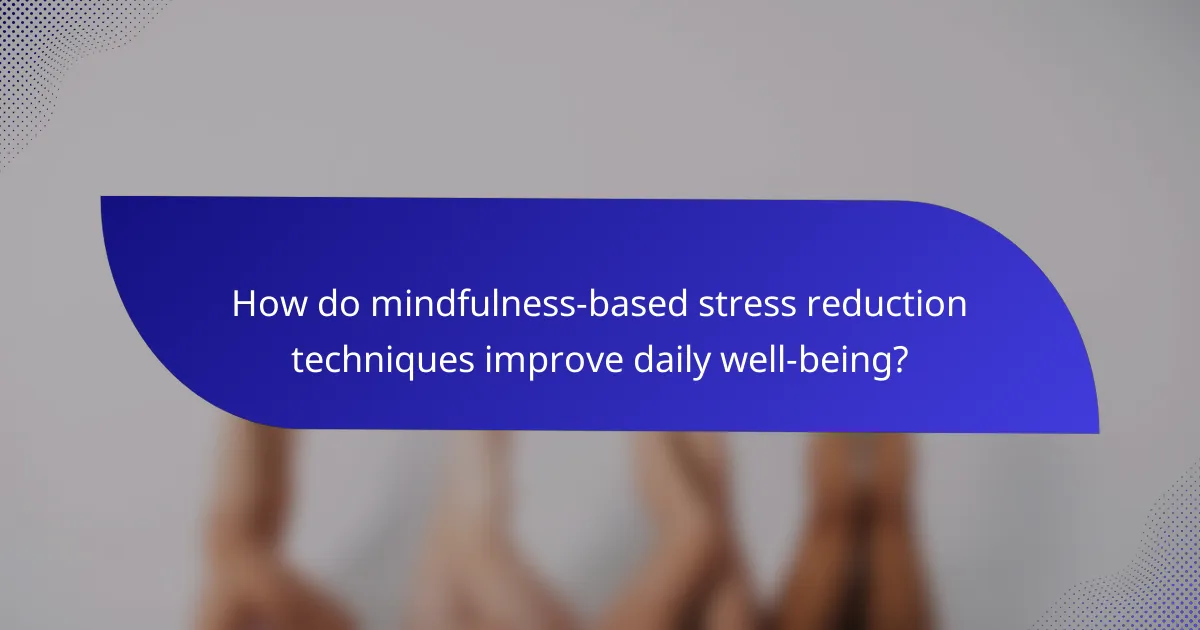
How do mindfulness-based stress reduction techniques improve daily well-being?
Mindfulness-based stress reduction techniques significantly enhance daily well-being by promoting emotional regulation and reducing anxiety. These techniques, such as meditation and mindful breathing, cultivate present-moment awareness, leading to improved mental clarity and resilience. Research indicates that regular practice can lower stress levels and increase overall life satisfaction. Engaging in mindfulness can also enhance interpersonal relationships by fostering empathy and compassion, creating a positive feedback loop that further supports well-being.
What are the psychological benefits of practicing mindfulness?
Practicing mindfulness offers significant psychological benefits, including reduced anxiety and improved emotional regulation. Mindfulness-Based Stress Reduction Techniques enhance self-awareness and foster a greater sense of well-being. These techniques can lower stress levels, improve focus, and increase resilience against negative emotions. Research indicates that regular mindfulness practice can lead to lasting changes in brain structure, particularly in areas associated with emotional regulation and self-referential processing. As a result, individuals often experience heightened clarity and a more positive outlook on life.
How does mindfulness enhance emotional regulation?
Mindfulness enhances emotional regulation by promoting awareness and acceptance of emotions. This practice allows individuals to observe their feelings without judgment, leading to healthier responses. Techniques such as focused breathing and body scans help reduce stress and increase emotional resilience. Research shows that regular mindfulness practice can significantly lower anxiety and improve overall emotional well-being.
Which mindfulness techniques are most effective for stress relief?
Mindfulness techniques such as meditation, deep breathing, and body scanning are effective for stress relief. These practices enhance awareness and promote relaxation, reducing anxiety and improving emotional regulation.
Meditation focuses attention and encourages a calm state of mind. Deep breathing exercises activate the body’s relaxation response, lowering heart rate and blood pressure. Body scanning increases awareness of physical sensations, helping to identify areas of tension.
Incorporating these techniques into daily routines can significantly improve overall well-being. Regular practice leads to long-term benefits, such as improved focus and resilience against stress.
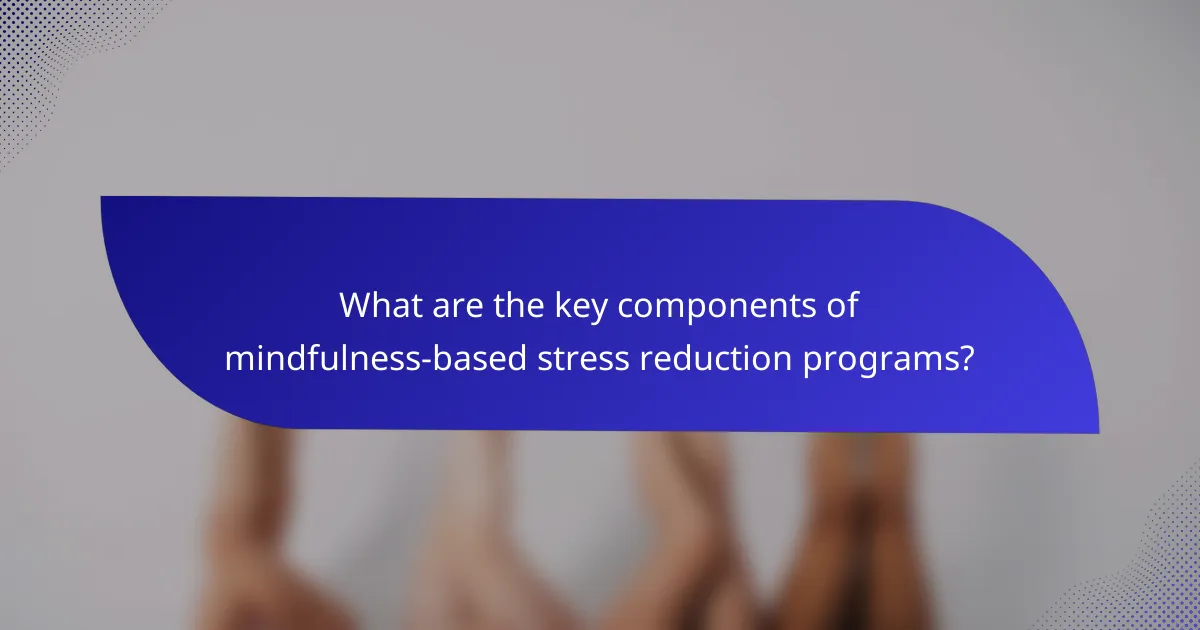
What are the key components of mindfulness-based stress reduction programs?
Mindfulness-based stress reduction programs incorporate several key components that enhance well-being. Core elements include mindfulness meditation, body awareness techniques, and mindful movement practices such as yoga. These components aim to cultivate present-moment awareness, reduce stress, and improve emotional regulation. The structured format typically spans eight weeks, involving weekly group sessions and daily home practice. Participants often report significant improvements in stress levels, anxiety reduction, and overall mental health, highlighting the effectiveness of these techniques in everyday life.
How is meditation incorporated into daily routines?
Meditation can be seamlessly integrated into daily routines through short, consistent practices. Start with five minutes of mindfulness meditation in the morning to set a positive tone for the day. During breaks, practice deep breathing or a brief body scan to alleviate stress. Incorporate mindful walking by focusing on sensations while moving. Before sleep, engage in guided meditation to promote relaxation. These techniques enhance mental clarity and emotional well-being, making mindfulness a part of everyday life.
What role does body awareness play in stress reduction?
Body awareness significantly contributes to stress reduction by fostering mindfulness and enhancing emotional regulation. It allows individuals to recognize physical sensations linked to stress, enabling proactive management. Techniques like body scanning and mindful breathing cultivate this awareness, promoting relaxation. As a result, practitioners often experience lower anxiety levels and improved overall well-being.
How can mindfulness be practiced in various environments?
Mindfulness can be practiced in various environments by incorporating specific techniques suited to each setting. In nature, focus on the sights and sounds around you to enhance your connection to the environment. In the workplace, take short breaks to engage in deep breathing exercises, allowing for mental clarity and stress reduction. At home, create a dedicated space for meditation, fostering a calm atmosphere. During daily activities, such as eating or walking, practice being fully present, paying attention to sensations and experiences. Each environment offers unique opportunities for mindfulness, enhancing overall well-being.
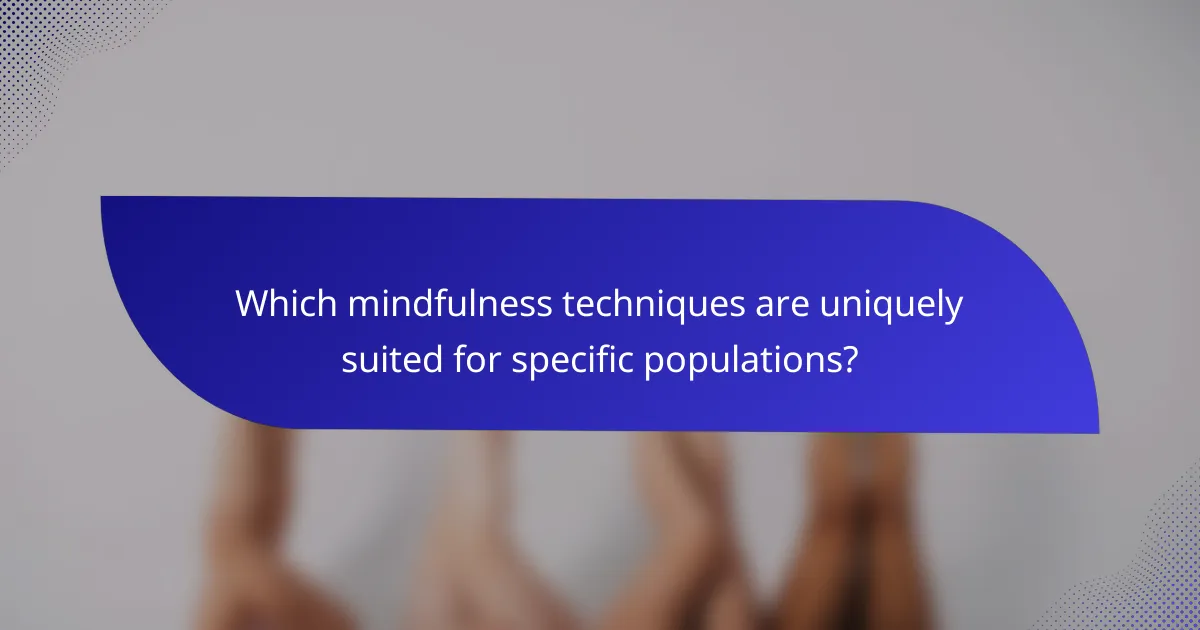
Which mindfulness techniques are uniquely suited for specific populations?
Mindfulness techniques can be tailored to meet the needs of specific populations. For instance, mindfulness practices for children often include playful activities like mindful breathing games. Seniors may benefit from gentle yoga and guided meditations that emphasize relaxation. Individuals with chronic pain can use body scan techniques to enhance awareness and reduce discomfort. For those in high-stress professions, brief mindfulness exercises integrated into the workday can improve focus and resilience. Each technique addresses unique attributes of the population, enhancing overall effectiveness.
How can mindfulness benefit students facing academic pressure?
Mindfulness benefits students facing academic pressure by enhancing focus, reducing anxiety, and improving emotional regulation. These techniques foster resilience and promote a healthier response to stressors. Mindfulness practices, such as meditation and breathing exercises, can be easily integrated into daily routines. Research shows that students who engage in mindfulness report lower stress levels and better academic performance.
What adaptations are effective for mindfulness in the workplace?
Mindfulness adaptations in the workplace enhance focus and reduce stress. Effective techniques include guided meditation sessions, mindful breathing exercises, and regular breaks for self-reflection. These practices promote emotional resilience and improve overall productivity. Implementing mindfulness training workshops can also foster a supportive environment, encouraging employees to engage in self-care.
How can parents implement mindfulness practices with children?
Parents can implement mindfulness practices with children by incorporating simple techniques into daily routines. Start by introducing short breathing exercises, encouraging children to focus on their breath for a few minutes. This helps cultivate awareness and calmness.
Engage in mindful activities such as nature walks, where children observe their surroundings and express gratitude for what they see. Create a calming space at home for mindfulness sessions, using soft lighting and comfortable seating.
Implementing mindfulness games can also be effective. Activities like “mindful listening,” where children listen to sounds around them, enhance focus and presence. Regular practice fosters emotional regulation and resilience in children, promoting overall well-being.

What are the challenges individuals face when adopting mindfulness practices?
Individuals face several challenges when adopting mindfulness practices, including difficulty in maintaining focus, managing expectations, and integrating techniques into daily routines. Many struggle with distractions, which can hinder their ability to be present. Additionally, unrealistic expectations about immediate results can lead to frustration. Time constraints often make it hard to practice consistently. Overcoming these obstacles requires patience, commitment, and a gradual approach to mindfulness integration.
Why do some people struggle with maintaining a mindfulness routine?
Some people struggle to maintain a mindfulness routine due to inconsistent motivation and external distractions. Many individuals face challenges integrating mindfulness into their daily lives. Root attributes like time constraints and unique attributes such as personal stress levels can hinder practice consistency. Additionally, rare attributes like lack of guidance or support may exacerbate these difficulties. Overcoming these barriers often requires tailored mindfulness strategies that fit individual lifestyles.
What misconceptions exist about mindfulness and stress reduction?
Many misconceptions about mindfulness and stress reduction hinder effective practice. One common belief is that mindfulness requires extensive meditation experience, while in reality, simple awareness techniques can be practiced daily. Another misconception is that mindfulness is solely about relaxation; it also enhances focus and emotional regulation. People often think mindfulness is a quick fix for stress, but it requires consistent practice for lasting benefits. Lastly, some believe mindfulness is a spiritual practice, while it can be secular and applied in various contexts, including workplaces and schools.
How can individuals overcome common barriers to mindfulness?
Individuals can overcome common barriers to mindfulness by practicing consistency, setting realistic goals, and creating a supportive environment. Regular practice helps integrate mindfulness into daily life. Setting achievable goals prevents frustration and promotes motivation. A supportive environment, including social connections and resources, enhances mindfulness engagement.
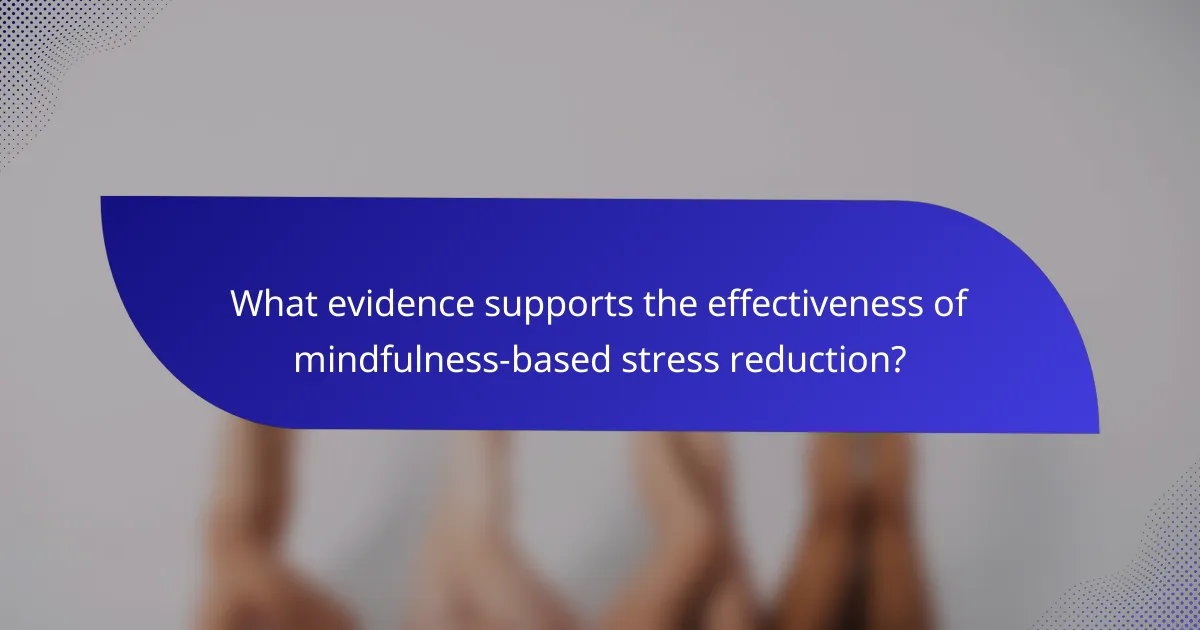
What evidence supports the effectiveness of mindfulness-based stress reduction?
Mindfulness-based stress reduction (MBSR) has strong evidence supporting its effectiveness in reducing stress and improving well-being. Numerous studies indicate that MBSR can lower anxiety levels, enhance emotional regulation, and improve overall mental health. For instance, a meta-analysis found significant reductions in stress and anxiety among participants who practiced MBSR compared to control groups. Additionally, brain imaging studies show structural changes in areas related to stress response, indicating a physiological basis for its benefits. These findings highlight MBSR as a valuable technique for managing stress in everyday life.
Which studies have shown significant outcomes in mental health?
Research indicates that mindfulness-based stress reduction techniques significantly improve mental health outcomes. Various studies have demonstrated reductions in anxiety, depression, and stress levels among participants. For instance, a meta-analysis found that mindfulness practices led to a 30% decrease in anxiety symptoms. Additionally, a randomized controlled trial revealed improvements in emotional regulation and overall well-being among individuals practicing mindfulness regularly. These findings underscore the efficacy of mindfulness in enhancing psychological resilience and promoting mental health.
How does mindfulness impact physical health metrics?
Mindfulness positively impacts physical health metrics by reducing stress and enhancing overall well-being. Techniques such as meditation and deep breathing lower blood pressure and improve immune function. Research shows regular practice can decrease cortisol levels, leading to better heart health. Additionally, mindfulness boosts mental clarity, which can improve lifestyle choices related to nutrition and physical activity.
What are the longitudinal effects of consistent mindfulness practice?
Consistent mindfulness practice leads to long-term benefits such as reduced stress, improved emotional regulation, and enhanced focus. Studies indicate that regular engagement in mindfulness techniques can reshape brain function and structure over time. For instance, participants in mindfulness programs showed increased gray matter density in areas associated with emotional regulation and self-referential processing. This transformation supports better mental health outcomes and resilience against stressors. Additionally, mindfulness fosters a greater sense of well-being, promoting a more positive outlook on life.
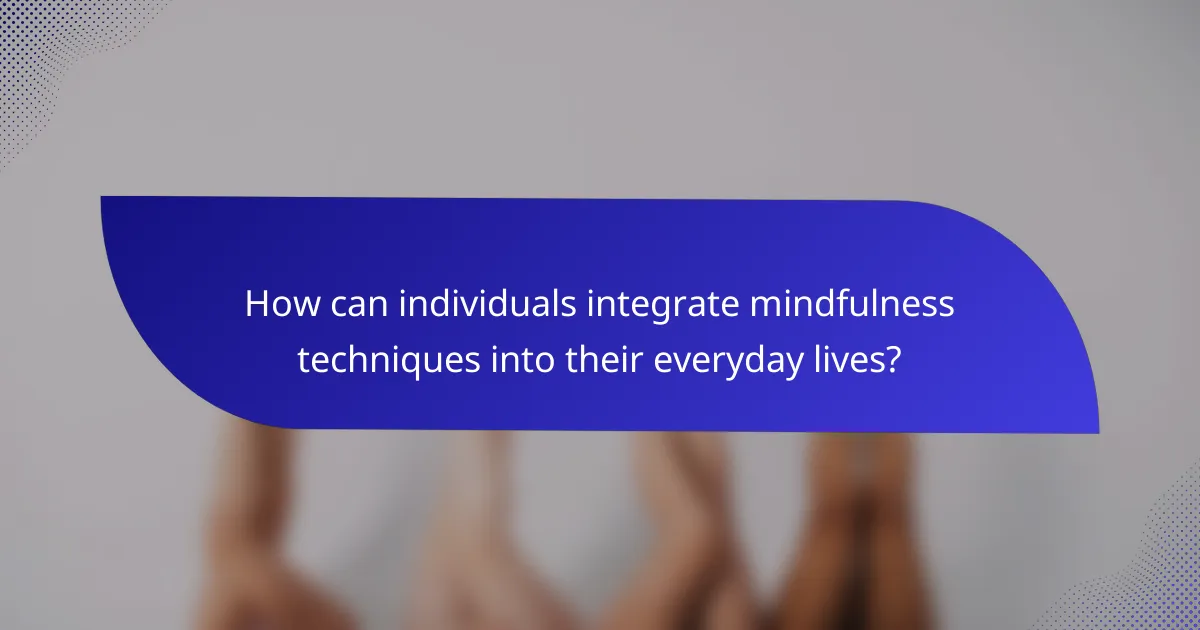
How can individuals integrate mindfulness techniques into their everyday lives?
Individuals can integrate mindfulness techniques into their everyday lives by practicing short meditation sessions, mindful breathing, and body scans. Start with five minutes of focused breathing each morning. Incorporate mindfulness during daily activities, such as eating or walking, by paying full attention to the experience. Use reminders to pause and check in with your thoughts and feelings throughout the day. These practices enhance awareness and reduce stress. Consistency is key; aim for daily integration to cultivate a lasting habit.
What are practical steps to start a daily mindfulness practice?
To start a daily mindfulness practice, begin with simple steps that fit into your routine. First, allocate a specific time each day for mindfulness, even if it’s just five minutes. Next, choose a comfortable location free from distractions. Focus on your breath, observing each inhalation and exhalation. Gradually increase the duration as you become more comfortable. Incorporate mindfulness into daily activities, such as eating or walking, to reinforce the practice throughout your day.
How can mindfulness be combined with other stress reduction strategies?
Mindfulness can effectively enhance other stress reduction strategies, such as exercise, deep breathing, and cognitive behavioral therapy. Combining mindfulness with physical activity improves focus and enjoyment, making workouts more effective. Integrating mindfulness into deep breathing practices enhances relaxation and emotional regulation. Additionally, applying mindfulness within cognitive behavioral therapy helps individuals recognize and alter negative thought patterns, promoting overall mental well-being. This multifaceted approach results in a more comprehensive stress management toolkit.
What are expert tips for maximizing the benefits of mindfulness?
To maximize the benefits of mindfulness, practice regularly, focus on your breath, and incorporate mindfulness into daily activities. Start with short sessions and gradually increase duration. Engage fully in the present moment, observing thoughts without judgment. Utilize guided meditations and mindfulness apps for structure.